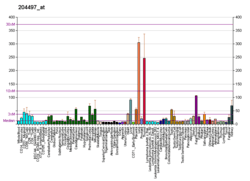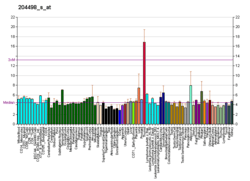ADCY9
Adenylyl cyclase type 9 is an enzyme that in humans is encoded by the ADCY9 gene.[5][6]
Function
Adenylyl cyclase is a membrane bound enzyme that catalyses the formation of cyclic AMP from ATP. It is regulated by a family of G protein-coupled receptors, protein kinases, and calcium. The type 9 adenylyl cyclase is a widely distributed adenylyl cyclase, and it is stimulated by beta-adrenergic receptor activation but is insensitive to forskolin, calcium, and somatostatin.[6]
References
- 1 2 3 GRCh38: Ensembl release 89: ENSG00000162104 - Ensembl, May 2017
- 1 2 3 GRCm38: Ensembl release 89: ENSMUSG00000005580 - Ensembl, May 2017
- ↑ "Human PubMed Reference:".
- ↑ "Mouse PubMed Reference:".
- ↑ Hacker BM, Tomlinson JE, Wayman GA, Sultana R, Chan G, Villacres E, Disteche C, Storm DR (Apr 1999). "Cloning, chromosomal mapping, and regulatory properties of the human type 9 adenylyl cyclase (ADCY9)". Genomics. 50 (1): 97–104. doi:10.1006/geno.1998.5293. PMID 9628827.
- 1 2 "Entrez Gene: ADCY9 adenylate cyclase 9".
External links
- Human ADCY9 genome location and ADCY9 gene details page in the UCSC Genome Browser.
Further reading
- Nakajima D, Okazaki N, Yamakawa H, et al. (2003). "Construction of expression-ready cDNA clones for KIAA genes: manual curation of 330 KIAA cDNA clones". DNA Res. 9 (3): 99–106. doi:10.1093/dnares/9.3.99. PMID 12168954.
- Paterson JM, Smith SM, Harmar AJ, Antoni FA (1995). "Control of a novel adenylyl cyclase by calcineurin". Biochem. Biophys. Res. Commun. 214 (3): 1000–8. doi:10.1006/bbrc.1995.2385. PMID 7575502.
- Premont RT, Matsuoka I, Mattei MG, et al. (1996). "Identification and characterization of a widely expressed form of adenylyl cyclase". J. Biol. Chem. 271 (23): 13900–7. doi:10.1074/jbc.271.23.13900. PMID 8662814.
- Nagase T, Ishikawa K, Miyajima N, et al. (1998). "Prediction of the coding sequences of unidentified human genes. IX. The complete sequences of 100 new cDNA clones from brain which can code for large proteins in vitro". DNA Res. 5 (1): 31–9. doi:10.1093/dnares/5.1.31. PMID 9628581.
- Barcova M, Speth C, Kacani L, et al. (1999). "Involvement of adenylate cyclase and p70(S6)-kinase activation in IL-10 up-regulation in human monocytes by gp41 envelope protein of human immunodeficiency virus type 1". Pflügers Arch. 437 (4): 538–46. doi:10.1007/s004240050815. PMID 10089566.
- Speth C, Joebstl B, Barcova M, Dierich MP (2000). "HIV-1 envelope protein gp41 modulates expression of interleukin-10 and chemokine receptors on monocytes, astrocytes and neurones". AIDS. 14 (6): 629–36. doi:10.1097/00002030-200004140-00001. PMID 10807185.
- Patke CL, Shearer WT (2000). "gp120- and TNF-alpha-induced modulation of human B cell function: proliferation, cyclic AMP generation, Ig production, and B-cell receptor expression". J. Allergy Clin. Immunol. 105 (5): 975–82. doi:10.1067/mai.2000.105315. PMID 10808179.
- Patrizio M, Colucci M, Levi G (2001). "Human immunodeficiency virus type 1 Tat protein decreases cyclic AMP synthesis in rat microglia cultures". J. Neurochem. 77 (2): 399–407. doi:10.1046/j.1471-4159.2001.00249.x. PMID 11299302.
- Toyota T, Hattori E, Meerabux J, et al. (2002). "Molecular analysis, mutation screening, and association study of adenylate cyclase type 9 gene (ADCY9) in mood disorders". Am. J. Med. Genet. 114 (1): 84–92. doi:10.1002/ajmg.10117. PMID 11840511.
- Speth C, Schabetsberger T, Mohsenipour I, et al. (2002). "Mechanism of Human Immunodeficiency Virus-Induced Complement Expression in Astrocytes and Neurons". J. Virol. 76 (7): 3179–88. doi:10.1128/JVI.76.7.3179-3188.2002. PMC 136041. PMID 11884542.
- Toyota T, Yamada K, Saito K, et al. (2002). "Association analysis of adenylate cyclase type 9 gene using pedigree disequilibrium test in bipolar disorder". Mol. Psychiatry. 7 (5): 450–2. doi:10.1038/sj.mp.4000992. PMID 12082561.
- Ludwig MG, Seuwen K (2003). "Characterization of the human adenylyl cyclase gene family: cDNA, gene structure, and tissue distribution of the nine isoforms". J. Recept. Signal Transduct. Res. 22 (1–4): 79–110. doi:10.1081/RRS-120014589. PMID 12503609.
- Small KM, Brown KM, Theiss CT, et al. (2004). "An Ile to Met polymorphism in the catalytic domain of adenylyl cyclase type 9 confers reduced beta2-adrenergic receptor stimulation". Pharmacogenetics. 13 (9): 535–41. doi:10.1097/00008571-200309000-00002. PMID 12972952.
- Cumbay MG, Watts VJ (2004). "Novel regulatory properties of human type 9 adenylate cyclase". J. Pharmacol. Exp. Ther. 310 (1): 108–15. doi:10.1124/jpet.104.065748. PMID 14996950.
- Tantisira KG, Small KM, Litonjua AA, et al. (2005). "Molecular properties and pharmacogenetics of a polymorphism of adenylyl cyclase type 9 in asthma: interaction between beta-agonist and corticosteroid pathways". Hum. Mol. Genet. 14 (12): 1671–7. doi:10.1093/hmg/ddi175. PMID 15879435.
- Kimura K, Wakamatsu A, Suzuki Y, et al. (2006). "Diversification of transcriptional modulation: Large-scale identification and characterization of putative alternative promoters of human genes". Genome Res. 16 (1): 55–65. doi:10.1101/gr.4039406. PMC 1356129. PMID 16344560.
- Olsen JV, Blagoev B, Gnad F, et al. (2006). "Global, in vivo, and site-specific phosphorylation dynamics in signaling networks". Cell. 127 (3): 635–48. doi:10.1016/j.cell.2006.09.026. PMID 17081983.
This article is issued from
Wikipedia.
The text is licensed under Creative Commons - Attribution - Sharealike.
Additional terms may apply for the media files.





